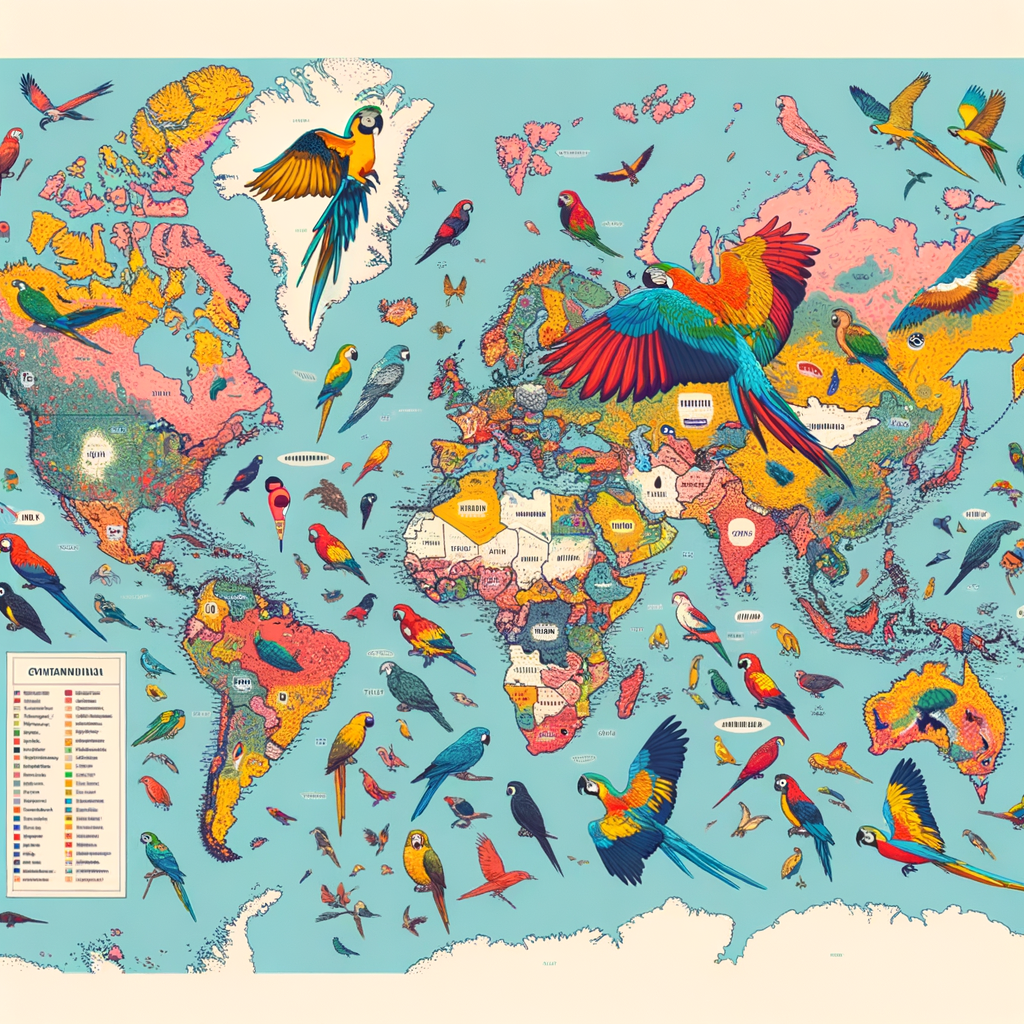
Introduction to Macaws
Welcome to the fascinating world of Macaws! These colorful and intelligent birds are a sight to behold in the wild. In this section, we will explore the different species of Macaws, their unique characteristics, and the diverse habitats they call home.
- Overview of Macaw species
- Characteristics of Macaws
- Macaw habitats worldwide
Macaws are a group of New World parrots that are known for their vibrant colors and large size. There are around 19 species of Macaws, each with its own distinct features and colors. Some of the most popular species include the Blue and Gold Macaw, Scarlet Macaw, and the Green-winged Macaw. However, there are also smaller species like the Hahn’s Macaw, which is just 12 inches long!
Macaws are known for their striking appearance, but they have many other unique characteristics. They have a strong, curved beak that they use to crack open hard nuts and seeds. Their feet are “zygodactyl”, meaning they have two toes facing forward and two facing backward, which helps them to grip branches and their food. Macaws are also highly intelligent and social birds. They can mimic human speech and are known to live in large flocks in the wild.
Macaws are native to the rainforests of Central and South America. However, they can adapt to a variety of habitats, including woodlands and savannas. Some species, like the Blue and Gold Macaw, have a wide range and can be found from Panama in Central America to Paraguay in South America. Unfortunately, due to habitat loss and illegal pet trade, many Macaw species are now endangered and their habitats are shrinking.
In the following sections, we will delve deeper into the types of Macaws, their distribution around the world, their habitats, and the efforts being made to conserve these magnificent birds. Stay tuned!
Types of Macaws
Macaws are a group of New World parrots that are colorful and highly intelligent. There are several types of macaws, each with their unique characteristics and colors. Let’s take a closer look at some of the most popular types of macaws.
- Blue and Gold Macaw
- Green-winged Macaw
- Scarlet Macaw
- Hyacinth Macaw
The Blue and Gold Macaw is one of the most recognizable types of macaws. As their name suggests, they have beautiful blue bodies with bright gold chests. They are known for their friendly and sociable nature, making them popular pets. These birds are also quite intelligent and can learn to mimic human speech.
Also known as the Red-and-green Macaw, the Green-winged Macaw is one of the largest of the macaw species. They have a striking red body with green wings, hence their name. These birds are known for their strong beaks that can crack nuts and seeds with ease.
The Scarlet Macaw is a large, red, yellow and blue South American parrot. They are known for their beautiful, vibrant colors and their loud calls. Scarlet Macaws are very intelligent and are known for their ability to learn tricks and mimic sounds.
The Hyacinth Macaw is the largest of all the macaw species. They are known for their stunning cobalt-blue plumage and their bright yellow eye rings and beak. Despite their large size, Hyacinth Macaws are known to be gentle and friendly.
These are just a few examples of the many types of macaws. Each species has its unique characteristics and beauty, making them a fascinating group of birds to learn about.
World Distribution of Macaws
Macaws are fascinating creatures. They are known for their vibrant colors and loud voices. But where can we find these beautiful birds? Let’s explore the world distribution of Macaws.
Distribution Maps
Understanding the distribution of Macaws can help us appreciate their diversity and learn about their habitats. We can use two types of maps to understand this: geographical distribution maps and habitat maps.
- Macaw Geographical Distribution
- Macaw Habitat Maps
Geographical distribution maps show where different species of Macaws can be found. Most Macaws are native to Central and South America. They can be found in countries like Brazil, Peru, Bolivia, and Mexico. Some species also live in the Caribbean. However, due to human activities, some Macaws have been introduced to other parts of the world.
Habitat maps, on the other hand, show the types of environments where Macaws live. Macaws typically live in rainforests, savannas, and swamps. They prefer areas with tall trees where they can nest and find food. Some species are also found in grasslands and mountainous regions. Understanding these habitats can help us protect these beautiful birds and their homes.
By studying these maps, we can learn a lot about Macaws. We can see where they come from, where they live, and how they interact with their environment. This knowledge is crucial for their conservation and our appreciation of these amazing creatures.
So, next time you see a Macaw, remember that it’s not just a beautiful bird. It’s a creature with a rich history and a wide distribution across the world!
Finding Macaws
If you’re a bird enthusiast, you might be wondering where you can find these colorful creatures known as macaws. Macaws are not just any ordinary birds; they are parrots with vibrant feathers and a loud voice. They are known for their beauty, intelligence, and social nature. But where can you find them in the wild? Let’s explore!
Macaw Locations
Macaws are native to certain parts of the world. They are not found everywhere, but in specific regions where the climate and environment suit their needs. Here are the main locations where you can find these beautiful birds:
- South America
- Central America
- Caribbean Islands
South America is home to a large number of macaw species. Countries like Brazil, Peru, and Bolivia have lush rainforests that provide the perfect habitat for these birds. In these forests, macaws can find plenty of fruits, nuts, and seeds, which are their primary food sources.
Central America, particularly countries like Costa Rica and Panama, also hosts several species of macaws. These birds are often seen flying in pairs or in large groups, known as flocks, across the sky. They nest in the hollows of trees and can often be heard before they are seen due to their loud calls.
The Caribbean Islands are another place where you can find macaws. These tropical islands provide an ideal environment for macaws, with plenty of trees for nesting and a variety of fruits for eating. The Scarlet Macaw, in particular, is a common sight on these islands.
Remember, macaws are wild animals and should be observed from a distance. They play an important role in their ecosystems, such as spreading seeds through their droppings, which helps new plants grow. So, if you’re lucky enough to spot one in the wild, enjoy the experience, but also respect their space.
In the next section, we’ll take a closer look at the different habitats of macaws. Stay tuned!
Macaw Habitats
Macaws, with their vibrant colors and impressive wingspans, are truly a sight to behold. These magnificent birds can be found in a variety of habitats around the world. Let’s explore some of the most common ones.
- Rainforests
- Savannas
- Grasslands
Many types of macaws call the lush, tropical rainforests their home. The dense foliage and abundant food sources make it an ideal habitat. Rainforests provide macaws with plenty of fruits, nuts, and seeds, which are their primary diet. The thick canopy also offers protection from predators.
Savannas, or tropical grasslands, are another common habitat for macaws. Here, they can often be found nesting in the hollows of trees. The wide-open spaces of the savannas allow these birds to fly freely and cover large distances in search of food.
Some species of macaws also inhabit grasslands. These areas, with their tall grasses and scattered trees, provide ample opportunities for foraging and nesting. Grasslands may not be as lush as rainforests or as wide as savannas, but they offer a unique environment that some macaws have adapted to.
In conclusion, macaws are versatile birds that can adapt to different environments. Whether it’s the dense rainforests, the expansive savannas, or the unique grasslands, these birds have found ways to survive and thrive. It’s a testament to their resilience and adaptability, traits that we can all learn from.
Conservation of Macaws
Macaws, with their vibrant colors and large size, are among the most recognizable and beloved birds in the world. However, these beautiful creatures are facing numerous threats that are causing their numbers to decline. Let’s explore these threats, the conservation efforts being made, and how we can all help.
- Threats to Macaw species
- Conservation efforts
- How to help
Macaws are primarily threatened by habitat loss and illegal pet trade. Deforestation is causing a significant reduction in their natural habitats, making it difficult for them to find food and breed. Additionally, they are often captured and sold as pets, which not only reduces their population in the wild but also exposes them to poor living conditions and stress.
Various organizations and governments are making efforts to conserve Macaws. They are establishing protected areas where deforestation is prohibited, and enforcing laws against the illegal pet trade. Some organizations are also running breeding programs to increase the population of these birds. For instance, the Ara Project in Costa Rica has successfully bred and released several species of Macaws into the wild.
Everyone can contribute to the conservation of Macaws. You can support organizations that work for their conservation by donating or volunteering. Additionally, you can help by raising awareness about the threats to these birds and the importance of their conservation. Remember, purchasing a Macaw as a pet contributes to the illegal pet trade, so it’s better to admire these beautiful birds in their natural habitats.
Macaws are an integral part of our planet’s biodiversity. Their conservation is not just about preserving their beauty, but also about maintaining the health of our ecosystems. Let’s all do our part to ensure these magnificent birds continue to grace our skies.
Conclusion
In this article, we’ve taken a journey through the colorful world of Macaws. We’ve learned about their different species, their global distribution, and their habitats. We’ve also discussed how to find these beautiful birds and the importance of their conservation. Now, let’s wrap up with a summary and some final thoughts.
- Summary of Macaw Species Worldwide
- Final Thoughts on Finding Macaws
There are 19 different species of Macaws found all over the world. The largest of these is the Hyacinth Macaw, which can reach lengths of up to 100 centimeters. The smallest is the Hahn’s Macaw, which is only about 30 centimeters long. Macaws are known for their vibrant colors, which can range from bright blues and greens to deep reds and yellows. They are found in a variety of habitats, including rainforests, woodlands, and savannas.
Finding Macaws can be a rewarding experience, but it’s important to remember that these birds are best observed in their natural habitats. If you’re lucky enough to spot a Macaw in the wild, remember to keep a respectful distance and avoid disturbing them. And if you’re considering getting a Macaw as a pet, remember that they require a lot of care and attention. They are intelligent and social creatures that need plenty of interaction and stimulation.
In conclusion, Macaws are a fascinating group of birds that add a splash of color to our world. Their beauty and diversity are a testament to the wonders of nature. As we continue to learn more about these birds, let’s remember the importance of conserving their habitats and ensuring their survival for future generations to enjoy.






